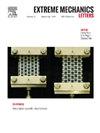基于六边形镶嵌的机械超材料
IF 4.5
3区 工程技术
Q2 MATERIALS SCIENCE, MULTIDISCIPLINARY
引用次数: 0
摘要
基于欧几里得多边形镶嵌的机械超材料代表了一类具有广泛机械性能潜力的新型建筑材料。在这项工作中,我们研究了一类基于具有三角旋转对称的一般六边形镶嵌的新系统,并展示了这种镶嵌如何有潜力表现出广泛的泊松比,包括弹性,以及杨氏模的大谱,同时保持横向各向同性。通过几何表达式来表征镶嵌,以确定几何参数的组合导致可实现的凹或凸结构,并使用有限元模拟来评估这些镶嵌的力学性能。此外,三个可代表整个泊松比范围(即负泊松比、零泊松比和正泊松比)的加性制造原型进行了实验测试,并使用数字图像相关技术进行了分析。从模拟和实验方法中获得的结果证明了这些镶嵌的机械能力,并表明如何通过探索欧几里得多边形瓷砖提供的巨大设计空间来发现新的auxetic超材料。本文章由计算机程序翻译,如有差异,请以英文原文为准。
Hexagonal tessellation-based mechanical metamaterials
Mechanical metamaterials based on Euclidean polygonal tessellations represent a new class of architectured materials with the potential to exhibit a wide range of mechanical properties. In this work, we investigate a new class of systems based on the generic hexagonal tessellation with trigonal rotational symmetry and show how this tessellation has the potential to exhibit a wide range of Poisson’s ratios, including auxeticity, as well as a large spectrum of Young’s moduli whilst retaining transverse isotropy. The tessellation was characterized through geometric expressions in order to identify which combination of geometric parameters lead to realizable, concave or convex configurations and Finite Element simulations were used to evaluate the mechanical properties of these tessellations. Furthermore, three additively-manufactured prototypes, representative of the entire Poisson’s ratio range (i.e. negative, zero and positive Poisson’s ratio) were experimentally tested and analysed using Digital Image Correlation. The results obtained from both simulation and experimental approaches demonstrate the mechanical capabilities of these tessellations and indicate how new auxetic metamaterials may be found by exploring the vast design space afforded by Euclidean polygonal tilings.
求助全文
通过发布文献求助,成功后即可免费获取论文全文。
去求助
来源期刊

Extreme Mechanics Letters
Engineering-Mechanics of Materials
CiteScore
9.20
自引率
4.30%
发文量
179
审稿时长
45 days
期刊介绍:
Extreme Mechanics Letters (EML) enables rapid communication of research that highlights the role of mechanics in multi-disciplinary areas across materials science, physics, chemistry, biology, medicine and engineering. Emphasis is on the impact, depth and originality of new concepts, methods and observations at the forefront of applied sciences.
 求助内容:
求助内容: 应助结果提醒方式:
应助结果提醒方式:


